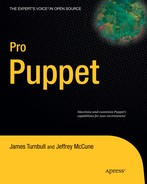Book Description
Pro Puppet is an in-depth guide to installing, using, and developing the popular configuration management tool Puppet. The book is a comprehensive follow-up to the previous title Pulling Strings with Puppet. Puppet provides a way to automate everything from user management to server configuration. You'll learn how to create Puppet recipes, extend Puppet, and use Facter to gather configuration data from your servers.
Puppet is a must-have tool for system administrators, and Pro Puppet will teach you how to maximize its capabilities and customize it for your environment.
Install and configure Puppet to immediately start automating tasks and create reporting solutions
Learn insider tricks and techniques to better manage your infrastructure
Become a Puppet expert!
What you'll learn
See how to install Puppet on a variety of platforms
Learn how to manage infrastructure with Puppet
Discover how to scale Puppet to suit small, medium, and large organizations
Learn how to integrate Puppet with other tools such as Cucumber and Nagios
Discover advanced Puppet techniques to make managing your environment easier
Learn how to develop and extend Puppet to suit your environment
Who this book is for
Systems administrators, implementers and systems integrators.
Table of Contents
- Copyright
- About the Authors
- About the Technical Reviewer
- Acknowledgments
- Introduction
- 1. Getting Started with Puppet
- 1.1. What Is Puppet?
- 1.2. Selecting the Right Version of Puppet
- 1.3. Can I mix releases of Puppet?
- 1.4. Installing Puppet
- 1.5. Configuring Puppet
- 1.6. Connecting Our First Agent
- 1.7. Creating Our First Configuration
- 1.8. Creating our first module
- 1.9. Applying Our First Configuration
- 1.10. Summary
- 1.11. Resources
- 2. Building Hosts with Puppet
- 3. Working with Environments
- 3.1. Configuring Puppet Environments
- 3.2. Testing the New Environments with the Puppet Agent
- 3.3. Environment Branching and Merging
- 3.4. Production Environment Releases
- 3.5. Summary
- 3.6. Resources
- 4. Puppet Scalability
- 5. Externalizing Puppet Configuration
- 6. Exporting and Storing Configuration
- 7. Puppet Consoles: Puppet Dashboard and The Foreman
- 7.1. Puppet Dashboard
- 7.2. The Foreman
- 7.3. Summary
- 7.4. Resources
- 8. Tools and Integration
- 9. Reporting with Puppet
- 10. Extending Facter and Puppet
- 10.1. Writing and Distributing Custom Facts
- 10.2. Developing Custom Types, Providers and Functions
- 10.3. Summary
- 10.4. Resources
- 11. Marionette Collective
- A. Working with Puppet
